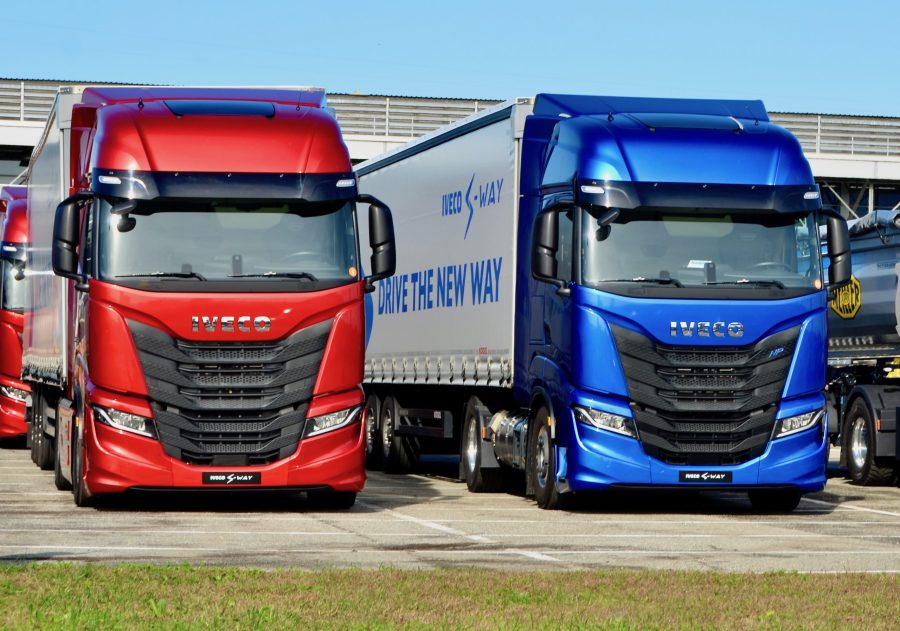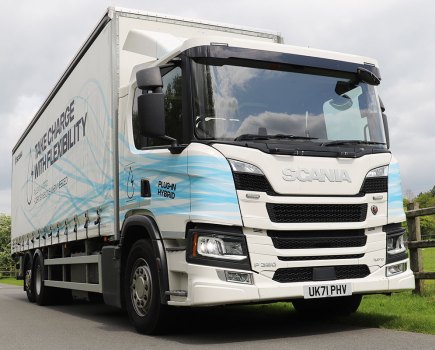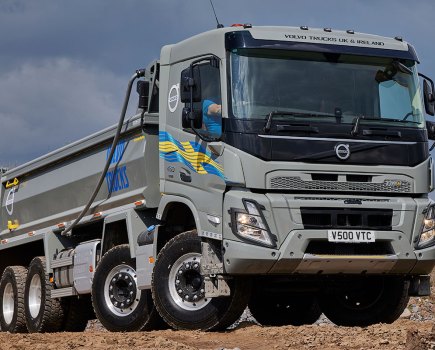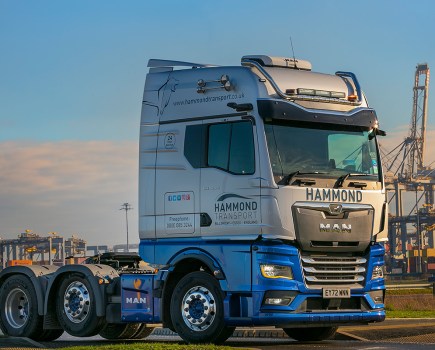Iveco has upped its game with its latest tractor units, with operators offered a choice of diesel or gas engines alongside a wealth of other upgrades and improvements aimed to make S-WAY stand tall alongside its competition.
Iveco was one of the first manufacturers to focus not just on the purchase price of a truck, but on the total cost of ownership (TCO). Now as the company’s long-serving Stralis moves aside for the new S-WAY, Iveco claims to have brought a restyled method of dealing with its customers to complement its newly restyled cab.
At a recent press conference, Gerrit Marx, president of commercial and speciality vehicles at Iveco, explained in full this renewed direction for the Italian company – and a significant factor of the direction is the joint venture between Iveco’s parent company Case New Holland (CNH) and electric vehicle developer Nikola. This strong co-operation between CNH and Nikola would seem to be a good fit and could well prove to be one of the most significant milestones in the move towards alternatively fuelled vehicles. This is an ongoing, developing project – and one that’s sure to gather pace in a relatively short time frame. We mention this in particular because it indicates why Iveco did not develop a completely new cab for the S-WAY – why would you when it is likely to change again soon?
Better by design
Nevertheless, we feel Iveco has done a worthy job on the styling and S-WAY is a good-looking truck. The new grille gives a contemporary profile and overall the exterior styling is neat and crisp, as well as being functional. This functionality delivers a 12 per cent reduction in aerodynamic drag, which Iveco claims can translate to a four per cent reduction in fuel consumption. This is attributed to the new cab profile, improved mirror assembly and other small enhancements – such as the entry steps covered when the door is shut, and some restyling of the roofline.
Iveco offers a choice of three different finishes for the multi-piece bumper which includes a step for the driver, and these can be carried around to match the truck’s sideskirts. Some thought has been invested in providing the driver with ample external storage lockers, which can provide up to 380 litres of space.
The S-WAY cab is available in three main configurations of the AS full sleeper; AT medium sleeper; and AD which is a low-roofed short cab. Both AT and AD are available in a narrower width option of 2300 mm. Similar options are available for Iveco’s X-WAY model, which is slightly more rugged and is aimed at operators whose work demands a more robust vehicle, such as those in the construction sector.
Once inside, the S-WAY’s interior layout has not changed dramatically from the Stralis – although this should not necessarily be viewed as a bad thing. When originally launched, Stralis was ahead of its time on many fronts, and the general upgrades since have managed to keep the cab modern and meet drivers’ needs. While it may not appear to be the largest cab on the road, S-WAY is somewhat deceptive and the internal floor-to-roof height of 2150 mm offers the driver a good sense of space.
Although many of the other improvements are relatively minor, the list is extensive and includes: full LED lighting inside and out, improved internal storage, USB connectors, a central locking security system, enlarged roof hatch, a swivel passenger seat, nighttime control panel, and an integrated pull-out table.
Other options include a selection of internal fridges with capacities up to 100 litres, and most of the comfort functions can be controlled via the MYIVECO driver’s app.
It was encouraging to discover some previous issues around the fit and finish of materials and components seem to have been addressed and significantly improved. Iveco also announced we can expect further upgrades in the near future, including a MirrorCam-style system with a recording capability.
NP priorities
In terms of alternative fuels, Iveco has to some degree ploughed a lonely furrow for many years; and while some manufacturers investigated the benefits of gas, they subsequently chose other directions. Iveco opted to continue with gas power, and believes it is now beginning to reap the rewards of developing its Natural Power (NP) range.
Iveco has invested heavily in a comprehensive development project that covers all aspects of producing real-world alternative fuelled trucks. These include improved fuel gauges with an accuracy tolerance of +/-3 per cent, new wheelbases to accommodate more tanks, and improved methods of locating gas tanks on the trucks to maximise capacity (especially for 6x2s) – with Iveco claiming S-WAY is the undisputed sustainable leader in long-haul transport.
By selecting the correct capacity gas tanks, S-WAY NP can achieve a range of 1600 km on one fill with a 4×2 tractor and semi-trailer combination. This does make the option of gas a more realistic proposition for many operators.
S-WAY is available with a choice of eight power options from Iveco’s Cursor 9, 11 and 13-litre diesels. In addition, Cursor 9 and 13 NP gas units offer a further choice of three power ratings. The diesels deliver from 330 to 570 bhp and torque from 1400 to 2500 Nm. The Cursor 9 and 13 gas units deliver 340, 400 and 460 bhp with 1500 to 2000 Nm torque. These engines are all matched to Iveco’s 12-speed Hi-Tronix transmission.
On the road
For our drive from the Fiat PowerTrain headquarters at the Industrial Village in Turin towards Mont Blanc, we chose the 480 bhp S-WAY with Cursor 11 diesel for the outward leg, and the 460 Cursor 13 CNG on the return. We found there was little if any difference between the performance of the gas or diesel truck.
However, what both S-WAYs deliver over the outgoing Stralis is a significantly quieter, smoother and more refined experience for the driver, which we feel will translate into an improved experience for the operator. One highlight in the area of road safety is Iveco claims a 15 per cent reduction in braking distance with S-WAY. We would agree in so far that we found the ride, comfort and handling of S-WAY to be good and the braking was even and well balanced.
Iveco has joined other manufacturers with a full suite of on-board technology, and now offers systems such as Hi-Cruise GPS which integrates Predictive Cruise Control, EcoRoll and Predictive Gear Shifting systems to deliver improved efficiencies for the operator. All of which can be monitored through the Iveco Driving Style Evaluation (DSE) system. DSE can generate reports on vehicle performance and driver behaviour, and if required will suggest areas of operation where improvements can be made.
While some questioned Iveco’s focus on gas as an alternative to diesel, the company has to date delivered over 35,000 gas-powered units to a wide variety of customers. In response to this criticism, Marx feels that “if you don’t have a gas offering for your customers, you won’t like gas and you will believe it won’t work”. He is sure that “for the newer (Facebook) generation, diesel does not have a future” – though in his opinion he believes “batteries are a chemical nightmare”. Nevertheless, he states “diesel will be with us for a while”.
Marx continues: “In reality, we are moving towards hydrogen as the only real alternative to fossil fuels. It is recognised as the only sustainable way to store energy.” However, that is as yet a long way off and natural power is the bridge to bring us there, and he states the popularity of gas is increasing quite dramatically. In 2018 there were 150 LNG stations in Europe; today in 2019 there are 230.
Also, Marx says the new vehicle emission standards being introduced in 2025, and set for further revision before implementation in 2030, will change the landscape dramatically. Although his outlook on this is positive, and he welcomes the challenge: “We did it with LNG and CNG and we will do it again.”
Stronger links
Recently all vehicle presentations will at some point touch on the subject of connectivity. Marx says that by 2020, 90 per cent of all European heavy-duty trucks will be connected. Iveco is keen to point out it will not charge operators who use its connected data systems, which can generate some useful information on the status of a haulier’s vehicles.
What is equally important is that with Iveco, the operators will ‘own’ the data generated by their connected vehicles. This, Iveco says, is highly important and it would seem is not always the case with other manufacturers who charge for the service.
It may have appeared that Iveco had gone somewhat quiet in recent times, and there may have been some truth in that. However, it would seem the company was simply taking stock and assessing the many changes that have occurred within the industry – and within society.
This has brought about the new S-WAY, and with the new truck there is a renewed sense of purpose with the company and a new sense of direction. “With S-WAY, we are closing the innovation cycle,” Marx says, “but we are also at the beginning of the next cycle.






